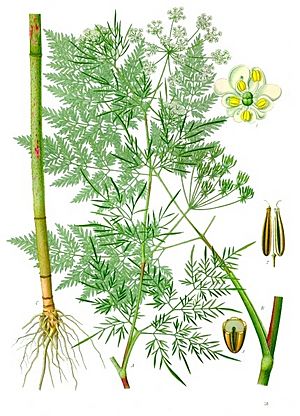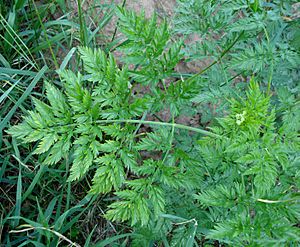Chaerophyllum bulbosum facts for kids
Quick facts for kids Chaerophyllum bulbosum |
|
|---|---|
 |
|
| Scientific classification | |
| Genus: |
Chaerophyllum
|
| Species: |
bulbosum
|
| Synonyms | |
|
|
Chaerophyllum bulbosum is a plant in the carrot family. It is known by many names, like turnip-rooted chervil or bulbous chervil. This plant comes from Europe and Western Asia. It was a very popular vegetable in the 1800s.
This tall plant grows every year. It has leaves that look like fringes and big groups of white flowers. People grow it in parts of Europe for its edible roots. These roots look like dark gray carrots with yellowish-white insides. After they are picked, they are stored in a cold place for a few months. This storage makes them sweeter.
Contents
About the Plant
How it Grows
Chaerophyllum bulbosum is a plant that lives for two years. In its first year, it grows many leaves. It stores a lot of energy in its main root, called a taproot. This energy helps the plant grow flowers in its second year. In the second year, it can grow very tall, from about 70 centimeters to over 2 meters.
The stem of the plant is smooth. It has bumps called nodes along it. Near the ground, the stem is hairy and might have red spots. The lower part of the stem often looks blue.
The leaves grow one after another along the stem. They are arranged in a spiral. Each leaf is made up of many smaller leaflets. The bases of the leaves wrap around the stem. As the plant gets bigger, the stem grows upwards. It becomes very branched, ready for flowers.
Its Flowers
Like other plants in the Apiaceae family, Chaerophyllum bulbosum produces many flower clusters. Each plant can have 10 to 200 of these clusters, called umbels. A single plant can produce between 1,000 and 36,000 flowers.
The flowers are special because the male parts develop first. This helps stop the plant from pollinating itself. Chaerophyllum bulbosum has both male and female flowers on the same plant. About 80% of the flowers are male, and 20% have both male and female parts.
Where it Grows Wild
This plant grows naturally in Europe, from Ukraine to France. It also grows from Sweden down to Italy. In countries like France and Germany, you can find it along the Rhine and Weser rivers. It also grows in Western and central Asia, including Turkey and the Caucasus region. In the wild, it often grows in thick groups along river banks. Its seeds are spread by water.
New Varieties
People have been growing this plant since the Middle Ages. For a long time, it was mostly a garden plant in France. It didn't have special names for different types. However, the first named type, called “Altan,” was created in France in 1986. Later, new types like “Véga” and “M4.10” were developed. These new types have seeds that sprout more easily.
How We Use It
The roots of this plant are used in cooking. They can be used for flavoring or cooked like other root vegetables. Much of the flavor comes from the skin of the root. The longer the plant is stored, the stronger its smell becomes.
If you eat it raw, it tastes a bit sharp, like a radish. But when cooked, it has a mild taste. It can taste like potatoes and chestnuts, with a slight hint of celery and parsnip. These roots have a lot of fiber. They are also rich in vitamins B and C and important minerals.
History of the Plant
Tuberous-rooted chervil comes from central and southeastern Europe. In the 1580s, its roots were sold in markets in Wien. By 1846, the roots arrived in France. About 16 years later, they became even more important. This was because a potato disease, called late blight, made potatoes hard to grow. So, people started growing chervil roots more as a potato substitute.
In the late 1900s, scientists started special growing programs. They wanted to improve this plant because of its delicate flavor. Thanks to French scientists, this plant became more important for farming. It is now grown in places like the Loire Valley in France and northern Brittany.
Growing the Plant
Growing this plant is similar to growing carrots and parsnips. It needs light, rich soil that is a bit moist. The plant grows for about 9 to 10 months. Its seeds need to be exposed to cold temperatures to sprout in the spring. So, people usually plant the seeds in the autumn.
The seeds need at least 8 weeks of continuous moisture and temperatures below 5°C. After this cold period, they sprout best when the temperature is between 5 and 10°C. If it's too hot (above 25 to 30°C), the seeds won't sprout well.
Seeds are planted directly in the ground from September to November. There's no need to grow small plants first. Rows are usually 20 to 25 centimeters apart. Seeds are spaced 4 to 6 centimeters apart in the row. In the first year, after sprouting in spring, the root grows. A group of leaves forms just above the ground. Small animals like Voles can be a problem for this crop.
Harvesting the Roots
The roots are ready to be picked when the leaves turn yellow in June. The main harvest time is from July to September. Because the seeds need a cold period, it's almost always necessary to plant new seeds right after harvesting the roots for the next season. This, along with low yields and poor seed sprouting, has made it hard for Chaerophyllum bulbosum to be grown widely by farmers.
How it Spreads
The main way to grow more of this plant is by saving its seeds after harvesting the roots. The seeds don't last long. This means they easily lose their ability to grow, especially in dry seed packets. So, it's best to use fresh seeds every year. Keeping the seeds in cool, slightly damp sand can help them stay good longer.
Insects like flies and beetles help pollinate Chaerophyllum bulbosum.
Plant Problems
Tuberous-rooted chervil can get similar diseases to carrots, parsnips, and other plants in the Apiaceae family. Common problems include the carrot fly, root rot during storage, and root aphids. It can also be a host for other types of aphids, a fungus called erysiphe heracley, or celery mosaic virus.
Gallery
See also
 In Spanish: Perifollo bulboso para niños
In Spanish: Perifollo bulboso para niños







